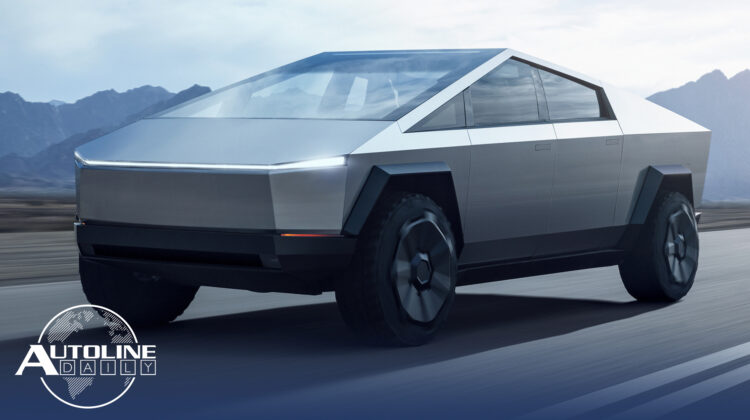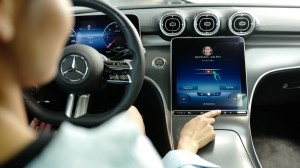
Listen to “AD #3519 – Tesla To Kill 12V Systems; GM Axes ICE Engine Program; China To Become #1 In Car Exports” on Spreaker.
Follow us on social media:
Runtime: 11:20
0:08 Higher Interest Rates Will Hurt Car Sales
0:56 VW Group Sells Fewer Cars, Posts Higher Profits
2:02 China to Become #1 In Car Exports
3:51 GM Axes ICE Engine Program
4:47 Honda Building Stationary Fuel Cells
5:52 Tesla to Kill 12V Systems
8:25 Tesla Cuts Model S & X Price
9:15 Scout Chooses South Carolina For Plant
9:55 Give Your Mercedes The Finger(Print)
Visit our sponsors to thank them for their support of Autoline Daily: Bridgestone, Intrepid Control Systems, and Schaeffler.
This is Autoline Daily, the show dedicated to enthusiasts of the global automotive industry.
HIGHER INTEREST RATES WILL HURT CAR SALES
The Federal Reserve in the U.S. is trying to stomp down on inflation by raising interest rates. But the Wall Street Journal reports that’s also hurting the manufacturing sector. Orders and exports for manufactured goods are down, and car sales could be next on the list. Higher interest rates make it harder for people with lower credit scores to get a car loan. And it raises the costs of those loans and lease rates, too. So just as the auto industry is starting to emerge from the chip shortage and put Covid lockdowns behind it, it’s getting hit with another crisis. In fact, we’re hearing a new word come into the automotive vocabulary: perma-crisis. It seems like this industry is just in a permanent crisis mode.
VW GROUP SELLS FEWER CARS, POSTS HIGHER PROFITS
The Volkswagen Group reported its earnings for last year and like every other automaker, it’s benefitting from raising prices and selling higher priced vehicles. But it also seemed to struggle to deliver cars to customers. The group, including VW, Audi, Seat, Skoda, Porsche and Lamborghini built 8.7 million vehicles last year. It sold 8.4 million. But it only delivered 8.2 million to customers. Financially, that didn’t hurt the company since automakers count a vehicle as sold as soon as it rolls off the assembly line. And that extra production sure showed up in the financial results. VW brought in €279 billion in revenue, up 12%. It posted an operating profit of €22 billion up 13% and a net profit of nearly €16 billion, up 2.6%. Last year the group sold 572,000 EVs, up 26% from the year before.
CHINA TO BECOME #1 IN CAR EXPORTS
We’ve got some interesting stats on the Chinese car market. There is so much excess manufacturing capacity in China that it’s ramping up exports to sell those excess cars in other countries. Last year China surpassed South Korea in car exports, it will surpass Germany this year and will likely surpass #1 Japan at some point in the future. Last year, 80% of the EVs sold in China were Chinese brands. Tesla accounted for another 15%, which means all the other foreign brands are fighting for only 5% of the EV market there. China is also exporting EVs and has one clear advantage, delivery times. In Europe, automakers typically take 6 months to two years to deliver EVs to customers but BYD does it in just a matter of days. The Wall Street Journal reports that in Australia, one customer was told he had to wait 8 months for a Tesla Model 3. So he bought a BYD Atto instead, got it faster and paid $23,000 less than what the Tesla cost.
GM AXES ICE ENGINE PROGRAM
GM might be spending a bunch of money on a new V8 engine for trucks and SUVs, but it’s giving up on another engine program. GM Authority reports that the automaker canceled a new twin-turbo inline 6-cylinder engine it was working on. That unit was rumored to be derived from GM’s 2.7L turbo-4, but with two more cylinders would have made around 500 horsepower and found its way into full-size trucks and SUVs. It doesn’t give a reason for the engine axing, but it was part of a program that wanted to optimize engine development and production through economies of scale. Maybe it felt like it wasn’t going to get that scale or it could have been investment needed for other programs? So, GM will use that new V8 and probably refine other engines to power its future full-size trucks and SUVs.
HONDA BUILDING STATIONARY FUEL CELLS
Honda is reportedly going to create a new subsidiary next month that will oversee the development of its EVs and batteries, but it thinks ICEs and eventually fuel cells will continue to share the market with battery electrics. And it just started operating its first stationary fuel cell power unit at its corporate campus in California. Each cube holds 4 fuel cell units, which for the tests come from previously leased Clarity fuel cell vehicles, and each cube generates nearly 290 kW of power. Honda is using two cubes for the test, but also says they can be arranged in L-, Z-shaped or other configurations. Future units will use the next-gen system it developed with GM, which will also power a CR-V in 2024, and they’ll be applied to other manufacturing facilities and data centers to offset costs during peak power demand as well as act as backup power generators.
TESLA TO KILL 12V SYSTEMS
Tesla has changed a lot of things in the auto industry and the next one on the list could be the voltage used in cars. In the first half of the 20th century cars ran on 6 volt systems, but as more electric accessories were added, cars in the US started switching to 12 volts in the mid-1950s. Engineers dreamed of going to 48 volts for decades, but they never could do it because OEMs and their suppliers had invested so much in 12 volt components. But starting with the Cybertruck, Tesla is going to 48 volts. Here’s what engineers Pete Banon and David Lau had to say at Tesla’s Investor Day last week.
(The Tesla Investor Day soundbite is only in the video version of today’s show.)
And so the Cybertruck could mark the beginning of the end of 12 volt systems.
TESLA CUTS S & X PRICE
Elon Musk said one of the big things holding customers back from buying a Tesla is being able to pay for one. And so Tesla is once again cutting prices in the U.S. This time it’s the Model S and X. The base version of the Model S is now just under $90,000 and the Plaid version is just under $110,000. That’s a $5,000 price cut for both. And the Model X’s base price has been slashed by 9% and now costs just under $100,000 while the Plaid variant is $110,000, an 8% drop. Tesla has cut prices on all of its models since the beginning of the year in order to boost demand. And it’s worked. The cuts have helped increase sales.
SCOUT CHOOSES SOUTH CAROLINA FOR PLANT
Scout Motors, Volkswagen’s new off-road EV brand, is ready to spend big to get back in the market. It’s going to build a brand new $2 billion assembly plant near Columbia, South Carolina. Construction will start in the middle of the year and production is expected to kick-off by the end of 2026, with an annual production capacity of 200,000 vehicles. It’ll be interesting to see how this goes. Tesla is going to start building an assembly plant in Mexico and so the race is on to see who can be the first to start rolling cars off the line.
GIVE YOUR MERCEDES THE FINGER(PRINT)
Mercedes is making it as easy to pay for gas as it is to open your phone. Customers in Germany are now able to make in-car payments with their fingerprint. Owners of the S-Class, EQS, EQE, GLC and C-Class can buy digital services as well as upgrade in-car convenience and technology features with fingerprint authentication. Later this year that will include paying for gas and the service will expand to other European markets. It’s easy to see why Mercedes is making in-car payments so easy. In its own press release it cites a study that says these services are expected to generate a transaction volume of 4.7 billion by 2026, and over the next five years, 48% of all in-car transactions will be people paying for gas.
But that brings us to the end of today’s show. Thanks for making Autoline a part of your day.
Thanks to our partner for embedding Autoline Daily on its website: WardsAuto.com
Seamus and Sean McElroy cover the latest news in the automotive industry for Autoline Daily.







